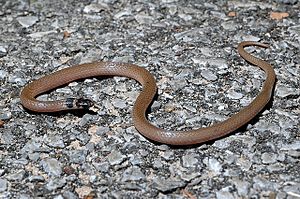Southeastern crown snake facts for kids
Quick facts for kids Southeastern crown snake |
|
|---|---|
 |
|
| Tantilla coronata in Florida | |
| Conservation status | |
| Scientific classification | |
| Genus: |
Tantilla
|
| Species: |
coronata
|
| Synonyms | |
The southeastern crown snake (Tantilla coronata) is a small, common snake. It belongs to a group of snakes called colubrids. This snake lives only in the southeastern United States.
Contents
What Does the Southeastern Crown Snake Look Like?
The southeastern crown snake is small and thin. It is usually grey-brown or light brown. Its head is black and pointed. There is a yellowish or cream band right behind its head. After this band, it has a black collar. This collar is about 3 to 5 scales wide. The rest of its back is reddish-brown. Its belly is light pink or white.
This snake has smooth scales on its back. These are called dorsal scales. Adults are usually about 20 to 25 centimeters (8 to 10 inches) long.
Where Does This Snake Live?
You can find the southeastern crown snake in many states. These include Alabama, northwestern Florida, Georgia, and parts of Indiana. It also lives in Kentucky, Louisiana, Mississippi, North Carolina, South Carolina, Tennessee, and Virginia.
These snakes like places with sandy or loose soil. They also like areas with lots of leaves and other plant bits on the ground. They live in both wet and dry forests.
How Does the Southeastern Crown Snake Behave?
This snake is active during the day when it's warm. You might find it under rocks, logs, or piles of leaves. When it gets cold in winter, it hibernates. But on warm winter days, it can still be active under the ground.
At night, especially in the early evening, the snake travels above ground. It is very good at burrowing in sandy soil. It can even seem to "swim" through the sand when it tries to get away.
What Does the Southeastern Crown Snake Eat?
The southeastern crown snake eats small creatures. Its diet includes termites, worms, centipedes, and insect larvae. It also eats spiders. This snake has small, sharp fangs in the back of its mouth. It uses these fangs to inject venom into its prey. But don't worry, these snakes are not harmful to humans.
Reproduction and Life Cycle
Southeastern crown snakes lay eggs. This means they are oviparous. They usually lay 1 to 3 eggs at a time. Mating happens from spring through fall. If a female mates in the fall, she can store the sperm until the next spring. Females usually lay their eggs in June and July. The baby snakes hatch in the fall.
Predators and Defense
Many animals that live in forests hunt southeastern crown snakes. These include other snakes like the kingsnake and coral snake. When threatened, the crown snake will try to burrow into the sand. It might also crawl under leaves or other things on the ground.
If you pick up this snake, it usually won't bite. Instead, it will release a stinky musk from its scent glands. This smell helps to scare away predators.
Conservation Status
For most areas where it lives, the southeastern crown snake is not in danger. But in Indiana, it is listed as an endangered species. This means it is at risk of disappearing there. If their forest homes are damaged or destroyed, it could harm the snake's population in the future.
Images for kids



